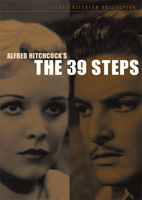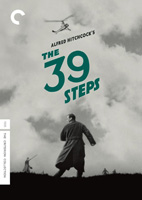1999:  2012:
2012: 

directed by Alfred Hitchcock
after the novel by John Buchan (1915)
adaptation by Charles Bennett; continuity by Alma Reville; dialogue by Ian Hay
Criterion #56.
I love this genre.
Movies like this transform “story” and “character” and “theme” into something more like one of those crib toys with ten different doodads: a bell and a spinner and a twirler and a ball and a phone and a rubber button and so on. Do they form a whole? Absolutely they do. Just look: it’s a whole. What ties that whole together, you might ask. But what kind of a question is that? Just look! Humpty Dumpty and Jack and the Beanstalk, and the Tortoise and the Hare and others. Obviously it’s about fairy tales etcetera. What is the phone there for, then, you might ask. But what kind of a question is that? Just look!
I will pretty much always take a good Fisher Price Activity Center movie over a movie with a message.
A good one, I said. What does it take for one of these movies to be “good”? Well, it does have to form a whole. You can look at the Fisher Price picture yet again if you need to: it’s all framed and united and designed. That is the function served by “plot” in these movies, and it’s an important function. In lesser movies, the various doodads are just dumped out of a box at your feet: here’s your damn Christmas present. That’s insulting.
So plot does matter quite a bit. But all the same, a movie like this does not actually tell a story; it just puts us inside a bubble of story-ness and then rings the bells and spins the spinners, without breaking the bubble. One arbitrary thing must lead to the next inexorably, as though this particular arrangement of doodads were actually a single perfect and necessary thing, being gradually revealed. There’s an art to it, but it’s an abstract art. Or a mostly-abstract art — like dance, or graphic design.
Because The 39 Steps is old and black-and-white and mostly shot on stagy sets, its bubble is very pure and complete. I felt cocooned in and safe, like I was floating with Glinda. Or, more aptly, coasting through the countryside in a luxe sleeper car, lulled by the muffled clacking of the tracks.
Hitchcock’s genius was his unwavering commitment to the bubble, even as over the course of his career the bells and spinners got bigger and louder. He was able to teach everyone else what was really going on at the movies: something unreal, something loopy and spooky and sensory. His coups de theatre are celebrated not just for their effect but for their instructional value as proof-of-concept. It wasn’t just that seeing a man on Lincoln’s nose was gratifying; it was also that a pioneering demonstration had been made of how and in what spirit it can be gratifying for there to be a man on Lincoln’s nose. Surrealism isn’t just for Freud, and nonsense isn’t just for jokes.
This is all to say that there should be a 39 Steps-themed crib toy. You could easily reskin the standard one to have Richard Hannay and a policeman running through the highlands along the bottom instead of the Tortoise and the Hare. One of the spinners can rotate to gradually reveal a picture of a hand missing a pinky. Etc.
Overheard at the laundromat just now. The very large woman who works there was folding clothes while watching TV. A customer stood next to her and watched with her for a minute.
Customer: What’s this?
Laundry lady: It’s Castle. You don’t watch Castle?? You’ve got to!
Customer: It’s about lawyers?
Laundry lady (delightedly correcting him): It’s a show!
She put it better than I did.
I am generally skeptical about “deep readings” of bubble movies like this. It’s not that I think they’re completely illegitimate; it’s just that they’re not usually done very sensitively. There’s a “visual essay” on the disc, in which a film scholar notes that the final shot of the movie, with chorus girls in the background and Mr. Memory dying in the foreground, juxtaposes “eros, the life instinct,” with “the death drive.” My objection isn’t that this is false; my objection is that it’s a clumsy, worthless way of gesturing toward something true. A kid watching naively, who has no clue what “the death drive” means or what such an analysis could possibly be saying, is better attuned to what’s really happening in that shot than an educated adult who has instant access to all the irrelevant cultural baggage that comes with those terms. Such analysis dumps extraneous crap in front of the film, blocking your view in the name of elucidation. Here’s your damn Christmas present, college boy.
Deep reading an image or a plot is basically a game. The Fisher Price Activity Center juxtaposes eros and the death drive too, come to think of it. Ask not for whom the bell goes ding!
Deep reading the psychology from which a movie springs, and to which it appeals, is another thing.
The sex in this movie takes the form of Madeleine Carroll taking off her wet stockings while handcuffed to Robert Donat, so that his hand can’t help but be along for the ride, no matter how limp and blameless he tries to make it. Subsequently, they have no choice but to sleep next to each other in a four-poster hotel bed. The appeal of the handcuff gag is the same as the appeal of “Seven Minutes in Heaven” and various other teenage contrivances to have sex forced on oneself: it relieves one of the responsibility of owning up to anything. It appeals to the repressed, who dare not pursue their own desire but would love for some hilarious fantasy circumstance to impose it on them. This is the framework for sex in so many old movies, and while it’s convenient for film scholars to talk about such devices as a way of getting stuff past the censors, I see it more as a way of appealing to widespread inner immaturity. God help us if these two characters were actually to have the hots for each other and acknowledge it: how drab and potentially tasteless. But if a Rube Goldberg machine appears and when the ironing board tips over and pulls the cat’s tail and releases the balloon, it yanks his hand so that he can’t help but touch her butt: now that’s entertainment!
As a teenager this stuff always seemed intuitively charming to me. But that’s because I was a teenager. Now I feel a little embarrassed for Hitchcock, or perhaps for all of Britain, snickering excitedly in the dark, sleepover party whispers, about “Well, but what if you were handcuffed together and then she got her stockings wet and had to take them off? Then you’d have to touch her leg! Snort!”
Okay, okay: it was still amusing. I guess at my present age I still thoroughly enjoy being yanked around by my trepidations about being hunted by a murderous spy or jumping from a moving train or whatnot; less so my trepidations about girls, because they’re much diminished. But yes, I can still “get it.”
And yes, it’s more complicated than all that, because Robert Donat’s character is not in fact snickering red-facedly; he is genuinely comfortable with whatever absurdly titillating circumstances happen to be dumped in his lap by fate. The fact that what’s happening to him would thrill a schoolboy amuses him. But we, the audience, are the ones thrilling, so we’re sort of the butt of that joke, aren’t we? “You should be so lucky, audience… and I should be so lucky,” thinks Alfred Hitchcock as he asks the actress to show a little more of her thigh. Doesn’t he? If these movies are based on his fears, one of those fears is clearly being put at risk of being aroused by a girl who has the composure that he lacks. Luckily his heroes always miraculously make it through the fire with their composure intact, just like they miraculously survive jumps from moving trains etc.
Music direction by Louis Levy, but as we learned back in The Lady Vanishes, that doesn’t mean he wrote it. The score is apparently actually by Jack Beaver, Charles Williams, and Hubert Bath. Which of the three was responsible for our selection? I don’t think anyone is alive who knows. I certainly don’t. Here’s the main title (opening with a fanfare for the British censor’s certificate: hooray, it was approved!). As with The Lady Vanishes, the main theme serves a clue-like function in the course of the movie. The way the main title is put together is extremely old-fashioned, typically operetta-like, but in my mind somehow that feels just right for this sort of movie. When the woodwinds and pizzicato cascade down toward the end (“PERIL!”), or when in the last few bars the fanfare resolves and then deresolves twice in a row a la Strauss (“HEROISM!”), I am completely charmed. If you close your eyes, you’ll feel like you could almost reach out and touch a mustache.
Beaver, Williams, and Bath sounds like a place to get nice candles.
Stuff on the disc: this interview, which is very good; this mini-documentary, forgettable; 22 minutes of the original Truffaut/Hitchcock interview tapes, fine (Truffaut describes various doodads as tres beau); the “visual essay” mentioned earlier, okay but bland; this radio version, just what it sounds like; and a few nice original production drawings like these.
The commentary track, by one Marian Keane, comes from the original 1999 disc and is firmly in the “By Martians For Martians” deflavorized academic mode. Sample sentence, her take on a POV shot: “When the newspaper is handed over to Hannay, we are in an intensely subjective sequence, and when Hitchcock sustains a subjective sequence, he’s investigating film’s capacity to reveal human subjectivity.” Typical BMFM mushy tautological nothingness; the word “investigating” is a classic red flag. I only made it about halfway through the movie and then stopped it. There’s really no point in subjecting myself to such stuff.
The black-and-white image is appealingly soft and sugary. Even after restoration, it does still flicker a bit. The sound isn’t great and probably never will be. There’s no getting around it: this movie is old.
As usual, Criterion’s packaging does some heavy compensatory lifting. “Actually guys,” it tells us, “old is the opposite of sell-out and sheep. It means taste and it means cachet. Duh, everyone knows that.” Well, that sounds great! That must mean the original period artwork would make a really hip cover, right? Right?